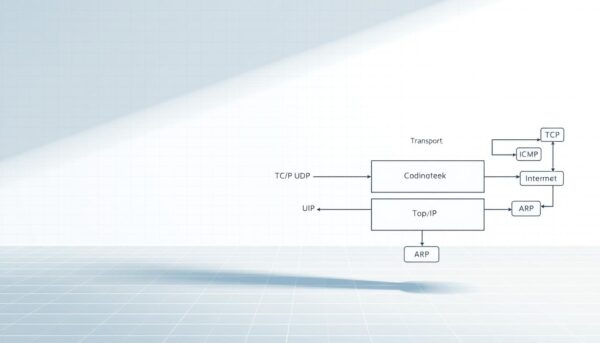✅ Last checked on
Ever wondered how websites appear instantly on your screen? It’s thanks to TCP/IP. This duo is key for sending emails, streaming videos, and making online purchases.
TCP/IP is the backbone of our global network. It’s a set of protocols that makes sure data moves safely and quickly. Without it, our internet would be a mess.
TCP/IP started in the early 1980s. It quickly became the standard for military networks. By 1983, it took over ARPANET, the first internet. By 1985, big companies like IBM and AT&T adopted it.
Today, TCP/IP is crucial for the internet. It supports everything from simple browsing to complex business apps. Its design has stood the test of time, over 40 years old.
Key Takeaways
- TCP/IP is essential for reliable data transmission across the internet
- It consists of four layers: Application, Transport, Internet, and Network Access
- TCP/IP was standardized in 1982 and fully adopted by ARPANET in 1983
- Major corporations like IBM and AT&T adopted TCP/IP by 1985
- TCP/IP powers a wide range of internet applications, from email to streaming
- The IETF maintains the technical standards for the Internet protocol suite
- IPv6 was proposed in 1995 to address IPv4 limitations
Understanding the Fundamentals of TCP/IP
TCP/IP is at the heart of how we communicate online today. This internet protocol suite connects devices and lets information flow smoothly. We often take this for granted.
What is TCP/IP and Its Core Functions
TCP/IP stands for Transmission Control Protocol/Internet Protocol. It’s a set of rules for data to be sent over networks. The main tasks of TCP/IP are:
- Addressing devices on networks
- Packaging data for transmission
- Routing data packets to their destinations
- Ensuring reliable delivery of data
The Evolution of Internet Protocols
The story of TCP/IP started in the 1970s with ARPANET. It has grown to meet the digital world’s needs. Important moments include:
| Year | Event |
|---|---|
| 1983 | ARPANET adopts TCP/IP |
| 1989 | Commercial Internet Service Providers (ISPs) emerge |
| 1995 | IPv6 introduced to address IPv4 limitations |
Basic Components of Network Communication
Network layers are key to TCP/IP. The four-layer model is:
- Network Access Layer
- Internet Layer
- Transport Layer
- Application Layer

Knowing TCP/IP basics helps us understand the internet. As you learn more about networking, you’ll see how this protocol suite makes our digital world work.
The Four-Layer Architecture of TCP/IP
The TCP/IP network architecture is key to the internet. It has four layers, each vital for data to move across networks. Let’s dive into these layers to see how they work together for smooth online interactions.
Application Layer: Where User Interaction Begins
The Application Layer is at the top. It combines functions from the OSI model’s top layers. Protocols like HTTP, HTTPS, and SSH live here, powering your apps and services. This is where your data journey begins, whether it’s an email or a website visit.
Transport Layer: Ensuring Reliable Data Flow
The Transport Layer is next. It’s home to TCP and UDP protocols. TCP ensures data is delivered reliably and in order. UDP is faster but doesn’t guarantee delivery. This layer breaks data into packets and manages their journey, making sure your messages arrive safely.
Internet Layer: The Digital Post Office
The Internet Layer is like a digital post office. It routes data packets across networks. It uses IP addresses to find devices and figure out the best path for data. This layer is key for connecting networks and making global communication possible.
Network Access Layer: The Physical Foundation
The Network Access Layer is at the bottom. It handles the physical side of data transmission. It works with network hardware like Ethernet cards and Wi-Fi adapters. It turns data into signals that can travel over physical media.
| Layer | Key Protocols | Primary Function |
|---|---|---|
| Application | HTTP, HTTPS, SSH | User interface and data formatting |
| Transport | TCP, UDP | End-to-end communication and data segmentation |
| Internet | IP, ICMP | Addressing and routing |
| Network Access | Ethernet, Wi-Fi | Physical transmission and hardware interfacing |
Knowing about these TCP/IP layers helps you understand how data moves from your device to its destination. Each layer builds on the last, making a strong and flexible system for global communication.
TCP: The Reliable Data Transfer Protocol
TCP protocol is key for reliable data transfer on the internet. It makes sure your data gets to its destination right and in order. This connection-oriented communication protocol is vital for many daily online activities.
When you browse a website or send an email, TCP works behind the scenes. It breaks your data into packets, assigns them sequence numbers, and sends them across the network. The receiving device then acknowledges each packet, confirming its arrival. If a packet goes missing, TCP resends it, guaranteeing complete delivery.

TCP’s reliability comes from its three-way handshake process. This establishes a connection before any data transfer occurs. Once the connection is set up, TCP manages the flow of data to prevent overwhelming the receiver. It also uses error-checking mechanisms to identify and correct any flaws in the received data.
| TCP Feature | Benefit |
|---|---|
| Connection-oriented | Ensures reliable delivery |
| Error checking | Identifies and corrects flaws |
| Flow control | Prevents receiver overload |
| Packet sequencing | Maintains correct order |
While TCP’s thoroughness can lead to slower speeds compared to connectionless protocols like UDP, its reliability makes it ideal for applications requiring accurate data transfer. From online banking to email delivery, TCP ensures your digital communications remain secure and intact.
How IP Addressing Works in Modern Networks
IP addressing is key to modern networks, giving each device a unique digital ID. Let’s explore how it works and why it’s important for your online life.
IPv4 vs IPv6 Addressing
IPv4 is the older system, using 32-bit addresses for about 4.3 billion unique IPs. But, as the internet grew, we needed more. That’s where IPv6 comes in, with 128-bit addresses, offering much more space.
Subnet Masking and Network Classes
IP networks vary in size. We organize them with network classes and subnet masking. There are three main classes: A, B, and C. Class C, for up to 256 hosts, suits small to medium businesses well.
Subnet masking, like 255.255.255.0 for Class A, helps break down big networks into smaller parts.
Domain Name System (DNS) Integration
Ever wonder how www.yourfavoritesite.com takes you to the right site? That’s DNS at work. It turns domain names into IP addresses. This makes browsing easy, letting you use names instead of numbers.
| Feature | IPv4 | IPv6 |
|---|---|---|
| Address Length | 32-bit | 128-bit |
| Address Space | 4.3 billion | Vastly larger |
| Format | Decimal | Hexadecimal |
Understanding IP addressing helps you see how data moves across networks. It’s the hidden system that makes sure your online pizza order gets to the right place!
Essential TCP/IP Protocols and Services
TCP/IP protocols are the heart of the internet. They work together to make sure data moves smoothly online. Let’s look at some key parts that make your online life easy.
The TCP/IP suite has many important protocols. IP deals with addresses and routes. ARP finds MAC addresses. ICMP sends error messages and checks networks.
TCP makes sure data gets to its destination safely. UDP is faster but less reliable. You use these protocols every day without knowing it.
When you surf the web, HTTP (port 80) brings you pages. For emails, SMTP (port 25) is the one. SSH (port 22) is for secure file transfers.
| Protocol | Port | Function |
|---|---|---|
| FTP | 20, 21 | File transfer |
| SSH | 22 | Secure login |
| SMTP | 25 | Email sending |
| HTTP | 80 | Web browsing |
TCP is key for keeping data safe. It waits for confirmations and sends data again if needed. This is why it’s great for emails and files.
For fast streaming, UDP is better. It doesn’t wait for confirmations, making it quicker but less reliable.
Knowing about TCP/IP protocols helps you understand how devices talk online. From checking social media to sending work emails, these services power your digital world.
Network Security in TCP/IP Implementation
In today’s digital world, keeping your data and systems safe is essential. TCP/IP, the internet’s foundation, faces many cybersecurity threats. Let’s look at ways to protect your network.
Common Security Threats
TCP/IP networks face many dangers. Denial of Service attacks can crash your system. Phishing scams target the Application Layer. Man-in-the-Middle attacks can harm your data by exploiting IP layer weaknesses.
Protection Mechanisms
To fight these threats, TCP/IP security uses several defenses. SSL/TLS protects web traffic at the Application Layer. IPsec adds security and encryption at the Internet Layer. VPNs create safe paths over public networks, boosting your network’s safety.
Best Practices for Network Safety
Strong network security practices are vital. Use firewalls to block unwanted traffic and Intrusion Detection Systems to catch attacks. It’s also important to educate users about phishing and to use strong, unique passwords. By following these steps, you’ll greatly improve your network’s security in the TCP/IP world.